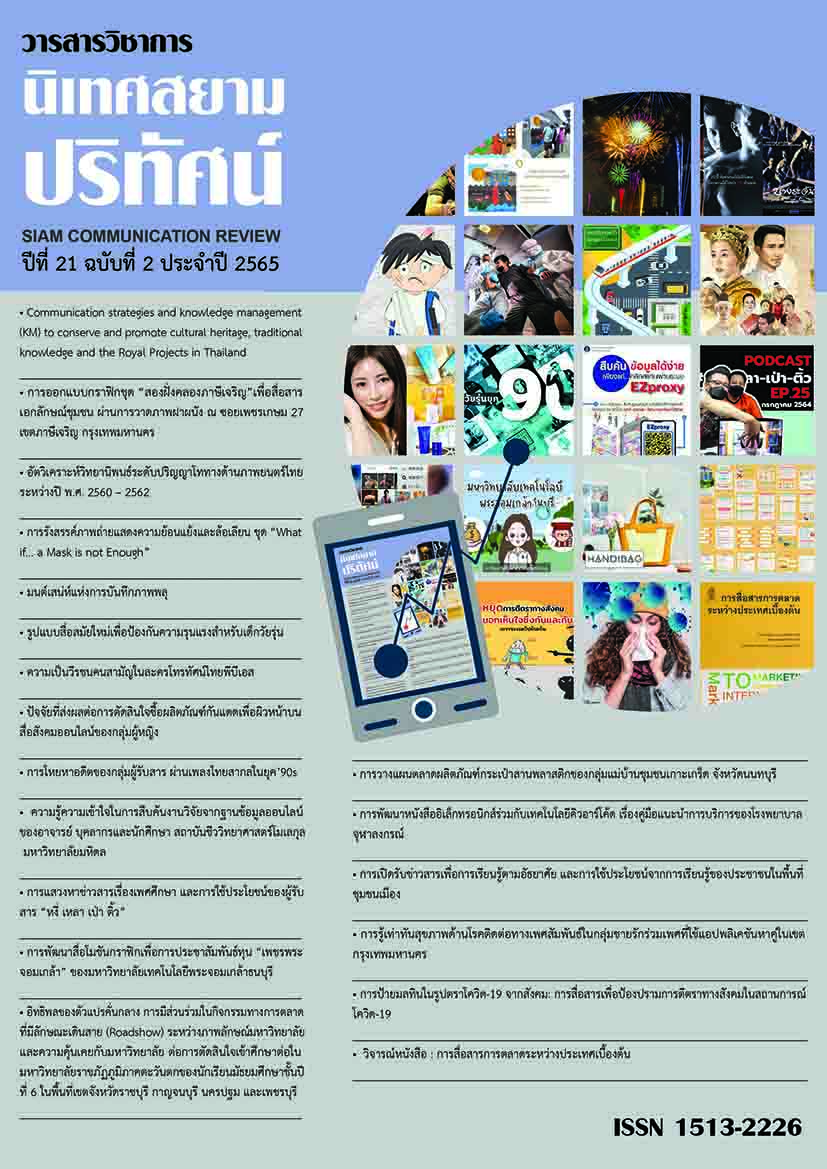Heroism from Common People in Thai PBS Television Drama
Main Article Content
Abstract
This qualitative research is content study that aimed to study 1) the creation of heroism from common people in Thai PBS television drama and 2) an analysis of the heroism characterization of common people in Thai PBS television drama.
The results showed that the creation of heroism from common people in Thai PBS television drama is mostly presented in drama and historical genres. The initiation of heroism from common people were 1) being a witness to others’ suffering 2) facing difficulty or suffering. The objectives of fighting were categorized into two categories: 1) fighting for morality that is ideal of humanity and 2) fighting for challenging and opposing unjust societal values or rules. As the story ending, the results pointed that there were three types of ending, 1) Pursuing a new dream or adventure. 2) Returning to their home towns, and 3) being injured or dying.
The key features of heroism from common people in Thai PBS television drama were bravery and sacrifice themselves for society. They never surrender their missions to obstacles. And the most importantly, they always overcome their evil selves. As in fighting style, it was found as an unarmed fight but they fight with aptitude, skill and knowledge about work and commitment in their mission. In addition, the common heroism in Thai PBS dramas was often across all genders and ages, and they were distributed in the regions of Thailand.
Article Details

This work is licensed under a Creative Commons Attribution-NonCommercial-NoDerivatives 4.0 International License.
References
กาญจนา แก้วเทพ. (2545). เมื่อสื่อส่องและสร้างวัฒนธรรม. กรุงเทพฯ: ศูนย์หนังสือจุฬาลงกรณ์มหาวิทยาลัย.
ณัฐ สุขสมัย. (2551). การสร้างความหมายใหม่ของ "วีรบุรุษและยอดวีรบุรุษ" ในภาพยนตร์ไทย. ปริญญานิเทศศาสตรมหาบัณฑิต, จุฬาลงกรณ์มหาวิทยาลัย.
ถิรนันท์ อนวัชศิริวงศ์ และ พิรุณ อนวัชศิริวงศ์. (2552). ละครสร้างนักอ่าน ศิลปะการละครเพื่อการส่งเสริมการอ่าน. กรุงเทพฯ : คณะนิเทศศาสตร์ จุฬาลงกรณ์มหาวิทยาลัย.
นัทธนัย ประสานนาม. (2559). สงครามโลกครั้งที่ 2 ในชีวประวัติทางโทรทัศน์เรื่อง บุญผ่อง: ความทรงจำโต้กลับกับความทรงจำข้ามชาต. ศิลปวัฒนธรรม, 37(7), 130-149.
นิธิ เอียวศรีวงศ์. (2536). การแสดงปาฐกถาพิเศษ ป๋วย อึ๊งภากรณ์ ครั้งที่ 4.กรุงเทพฯ: คณะเศรษฐศาสตร์ มหาวิทยาลัยธรรมศาสตร์.
บัญยง พูลทรัพย์, สมสุข หินวิมาน, และโสภัทร นาสวัสดิ์. (2562). การสร้างภาพตัวแทนวีรบุรุษสามัญชนในภาพยนตร์ไทย. Dhurakij Pundit Communication Arts Journal, 11(2), 181-207.
บุศยรินทร์ สัจจะวรรณน์. (2555). ได้ภาพลักษณ์เกาหลีผ่านละครโทรทัศน์ชุดแดจังกึม. วิทยานิพนธ์ปริญญาวารสารศาสตรมหาบัณฑิต, สาขาวิชาสื่อสารมวลชน คณะวารสารศาสตร์และสื่อสารมวลชน มหาวิทยาลัยธรรมศาสตร์.
ภาวิน มาลัยวงศ์. (2556). การ์ตูนซูเปอร์ฮีโร่และความเป็นวีรบุรุษในวัฒนธรรมอเมริกัน. Humanities Journal, 20(2), 90-110.
วรรณยศ บุญเพิ่ม, เอกลักษณ์ โภคทรัพย์ไพบูลย์, และ ไตรรัตน์ สิทธิทูล. (2018). การศึกษาพัฒนาการของอุตสาหกรรมตัวละครซุปเปอร์ฮีโร่สัญชาติไทย และแนวทางการพัฒนาเพื่อความสำเร็จอย่างยั่งยืน. วารสารวิชาการนวัตกรรมสื่อสารสังคม, 6(2), 211-222.
Cambell J. . (1968). The hero with a thousand faces. New Jersey Princeton University Press.
Frago Marta. (2017). Reconfigurations of the classical hero in the digital age: Aaron Sorkin’s the social network and Steve Jobs. FOTOCINEMA. Revista científica de cine y fotografía. Retrieved from https://doi.org/10.24310/Fotocinema.2017.v0i14.3597
Wildt Michael, & Selwyn Pamela. (1996). The Invented and the Real: Historiographical Notes on Schindler's List. Retrieved from https://www.jstor.org/stable/4289442
vipa. (2019). บุญผ่อง. [Video]. Retrieved from https://vipa.me/th/watch/series/details/บุญผ่อง/68025
vipa. (2010). หมอหงวน แสงดาวแห่งศรัทธา. [Video]. Retrieved from https://vipa.me/th/watch/series/details/หมอหงวน-แสงดาวแห่งศรัทธา/68009
vipa. (2017) อำแดงเหมือนกับนายริด. [Video]. Retrieved from https://vipa.me/th/watch/series/details/อำแดงเหมือนกับนายริด/68023
Telemovie ภาพยนตร์โทรทัศน์. (ม.ป.ป.). เข้าถึงได้จาก https://hmong.in.th/wiki/Television_film
Thai PBS Audio Description. (2015, 15 กรกฎาคม). [AD] ละครชุดคนบันดาลใจ : คู่มือเด็กดื้อ (1/2) [Video]. เข้าถึงได้จาก https://www.youtube.com/watch?v=7CiAzFvbMJk
Thai PBS Audio Description. (2015, 15 กรกฎาคม). [AD] ละครชุดคนบันดาลใจ : คู่มือเด็กดื้อ (2/2) [Video]. เข้าถึงได้จากhttps://www.youtube.com/watch?v=uhiC8Qd3kAI&t=2881s
Thai PBS Audio Description. (2015, 15 กรกฎาคม). [AD] ละครชุดคนบันดาลใจ : ลมหายใจใต้น้ำ (1/2). [Video]. เข้าถึงได้จาก https://www.youtube.com/watch?v=1CHXLXoFaIw
Thai PBS Audio Description. (2015, 15 กรกฎาคม). [AD] ละครชุดคนบันดาลใจ : ลมหายใจใต้น้ำ (2/2). [Video]. เข้าถึงได้จาก https://www.youtube.com/watch?v=d3hxNkSwOoY
Thai PBS Audio Description. (2015, 15 กรกฎาคม). [AD] ละครชุดคนบันดาลใจ : แสงปลายฟ้า (1/2). [Video]. เข้าถึงได้จาก https://www.youtube.com/watch?v=2nkOd1A61Og
Thai PBS Audio Description. (2015, 15 กรกฎาคม). [AD] ละครชุดคนบันดาลใจ : แสงปลายฟ้า (2/2). [Video]. เข้าถึงได้จาก https://www.youtube.com/watch?v=1i_xNl_0e_k&t=2573s
คีตกวีไทย หลวงประดิษฐไพเราะ. (n.d.). ละครไทยโหมโรง. [Video]. เข้าถึงได้จาก https://www.youtube.com/channel/UCZefL1F6HvgDeBH6lwOwvtw/videos
องค์การกระจายเสียงและแพร่ภาพสื่อสาธารณะแห่งประเทศไทย. (n.d). เกี่ยวกับไทยพีบีเอส. เข้าถึงได้จาก https://org.thaipbs.or.th/organization/vision


